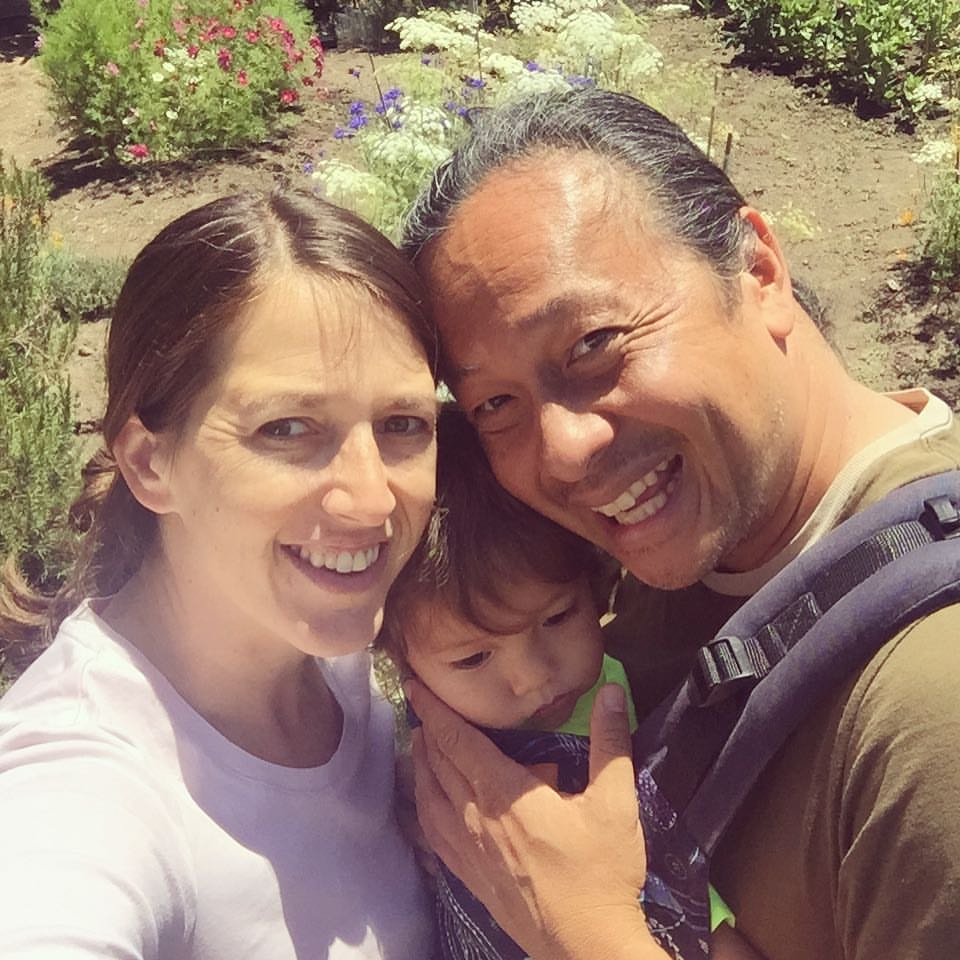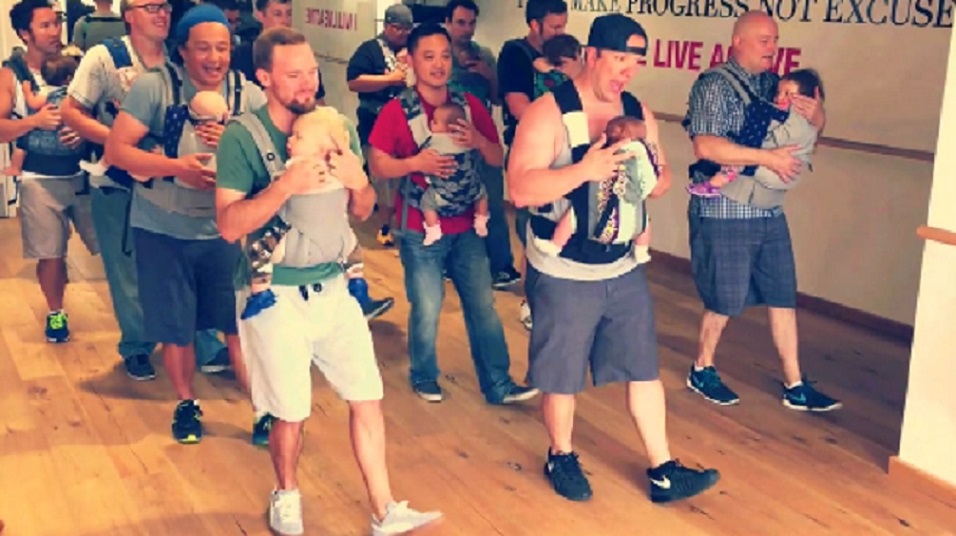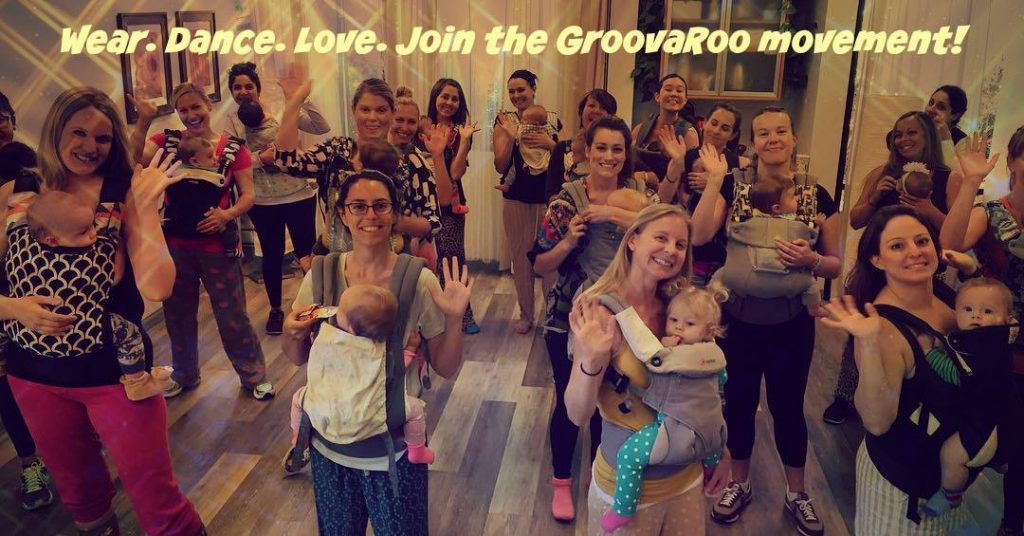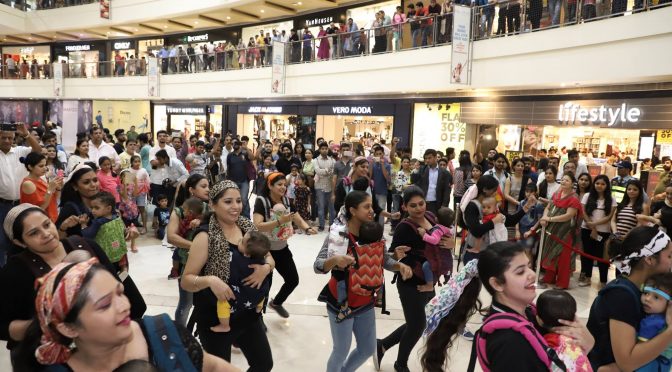The following interview with Amber and Meeshi Anjali, founders of GroovaRoo Dance™ and the magic behind 8 viral videos of babywearing dance, appears in Dancing with Your Baby–The Science of Nurturing Infant and Caregiver through Music and Movement [Available in paperback and ebook through Amazon]
Interview with Amber and Meeshi Anjali, founders of GroovaRoo Dance™
I’m delighted to have this opportunity to introduce you to Amber and Meeshi Anjali, founders of GroovaRoo Dance™. They offer classes and teacher training in babywearing safety and dancing with a baby in a soft structured carrier, meh dai & stretchy wrap carrier. I highly recommend their method of babywearing dance in a group setting and their teacher training. Amber has worked with babies and children all her life. Amber is a Certified Babywearing Educator through the Center for Babywearing Studies and has supported women in their transition into motherhood as a Birth Doula, Placenta Encapsulation Specialist, Postnatal Yoga Instructor and Nanny. Meeshi has been a dance instructor for 20 years.

How did you get started leading a dancing with your baby class?
Two years ago, Amber worked in the daytime as a birth doula and nanny for infants and toddlers while Meeshi worked nights as a ballroom and line dance instructor for adults. Once we found out we were pregnant with our son, Aemon Koa, we were determined to find a way to shift our work schedule so that we could raise our child together. Amber had the vision to do dance classes with babies using the gentle, baby-friendly movements of Soul Line Dancing. We did some research, and other than babywearing ballet, there wasn’t anything in America close to what we envisioned. So we decided to go for it, and thus, GroovaRoo Dance™ was born.
Meeshi, what motivates you to dance with your son?
Growing up as an Asian-American male in the 70-80’s, dancing was not a socially acceptable option for me. I lived my childhood like most other boys of my generation, feeling stiff and disconnected from my body. On my 25th birthday, I remember looking in the mirror and having this realization that I was just a “talking head” that felt numb from the neck down. That day, I made a commitment to myself to try anything to reconnect myself to my body. I first started with “talk therapy” but eventually found my salvation through taking African-based dance classes. I took Afro-Caribbean dance, then Brazilian dance, Cuban folkloric dance, and Lindy Hop swing dance, any music that involved drums and a syncopated beat. Then 5 years ago, someone posted a Soul Line Dance video on my Facebook page, and I’ve been hooked ever since. GroovaRoo Dance™ is very important to me because my core mission in life is to help empower American boys and men to own dance as our birthright and be as comfortable with dance as men are in Africa, Latin America, and parts of Asia. Also, I want my boy to grow up in a culture where boys dancing is not only acceptable, but encouraged, and the best place to create that cultural shift is by dancing with our boys while they are still babies. I am not necessarily interested in seeing more boys become dance professionals, but in having more families dancing together as a regular interactive social activity.
What is your main objective leading this activity?
For us personally, dancing fills our whole bodies with joy–and what better gift to give your child than to have them experientially feel your joy as you dance heart-to-heart with them. Also, central to all of our classes is our core “CONNECT FOUR” philosophy. As important as the dance steps themselves, we encourage all our GroovaRoo Dance™ teachers to focus on the following four connections: 1) connecting caregivers to themselves (self-care by releasing stress and body tension through dance), 2) connecting caregivers to their babies (infants are worn facing in for a heart-to-heart connection, and caregivers always have hands on babies giving them an extended hug), 3) connecting caregivers to each other (counteracting postpartum depression through social bonding and having fun together), and 4) connecting caregivers to the “collective groove” (giving them a sense of something bigger than themselves through synchronized movement to soulful music). We truly believe our CONNECT FOUR philosophy is instrumental in creating a community of happier, healthier and more empathetic caregivers and babies. Through babywearing dance, we are family.
Explain the dance routine, how do you begin, how does the dance proceed, and how does it end?
Our dance classes typically begin with an opening circle where we all introduce ourselves and our babies, then Amber does a brief babywearing safety check-in (much like an airline attendant) where we go over our 5 safety checkpoints: Baby Facing In, Spread Squat Seat, Baby is High and Tight, Keep Baby’s Airway Open, and finally a reminder to check in with baby’s Temperature and to stay Hydrated. Next, we do some stretching and a fun warm-up while still in a circle. The main purpose of our warmup is to get everyone connected together as a group through looking at each other and doing simple movements in unison. After that we take a 3-minute break before proceeding to teach our first of two dances. We first demonstrate the dance, breaking it down into easy digestible parts, and then practice doing it with the music. We are constantly reminding everyone to continually check-in on baby and each other. The teaching of each dance usually takes about 15 minutes, then we take another 3-min break before going to the second dance. After the second dance, we go straight to our cooldown where we stand in a circle, stretch a little, do simple movement together and end with singing feel good songs to our baby to songs like “Three Little Birds” by Bob Marley or “Don’t Worry Be Happy” by Bobby McFerrin. We all high-five and hug each other, then typically hangout and socialize for another 30 minutes after class. Even though, the babies don’t interact much during class-time, they are very close to each other and have bonded together through the synchronized, joyful movements of their caregivers.
What music do you use? What music have you found the babies are most receptive to?
Because our dancing is based on Soul Line Dancing, we primarily use R&B/Soul/Funk music from the 60’s to today during our warm-up and dances. (In our Cooldown, we use a greater variety of music, ballads, reggae, folk, Hawaiian). What is wonderful about Soul music is that there is a wide diversity of aesthetic feels within this genre from slow ballads, to mid-tempo shuffles to up-tempo funk (although we don’t dance to high up-tempo music for safety reasons). Babies seem to have a diversity to preferences to the music, but what we’ve observed is that if the caregiver is really enjoying the music, the babies do too. Side Note: We deliberately stay within the R&B/Soul genre, because we’ve personally found it easier to get people to move in synchrony with each other with this type of music than with other styles of music. We choose to use classic or well-known R&B songs, because dancers tend to relax more when they already know the song they are dancing to.
Many parents find using a baby carrier helpful when they need to move about, whether in or out of the home, so it is natural to see a baby being rocked or danced while in one–how do the babies respond when in a group dancing?
GroovaRoo Dance™ is all about group dancing and the collective healing power of people moving in synchrony. From our observations, if the caregiver is relaxed and having fun, then babies are relaxed and having fun. So the babies who come to our classes regularly grow closer to each other as their caregivers grow closer to each other, too. Love is a two-way street.
Do you ever have participants not use one?
As a babywearing dance class, all participants wear their babies. But our greater vision is to expand our program beyond babywearing to be an all-inclusive Family Dance Project where caregivers are able to dance with their kids and other similarly-minded families before and after the babywearing phase: pre-natal, infant/baby, toddler/preschooler, school age, and adolescent/teenagers. In collaboration with you, Luma Yoga and Motion Pacific, we are moving to Santa Cruz with the intention of making our family dance vision a reality.
GroovaRoo Dance™ is quite active on Facebook and Instagram, indeed you had a video go viral–why do you think that was? And where in the world has it been received most enthusiastically?
If 1,000,000 views is considered “going viral”, then we have gone viral with 8 of our dance videos, and we have 20 videos with over 100,000 views. I am not sure if we’ll ever reach this height of virality again (since the initial novelty of babywearing dance has worn off), but we hope with our new Family Dance Project that our new videos will still keep reaching more and more families worldwide until family dancing becomes the norm rather than the exception. Why did our videos go viral? Like any cultural phenomenon, we think it was being at the right place at the right time. Most viral videos tend to include either dogs/cats, babies and/or dancing. We got 2 of the 3, plus when you add the element of dads dancing, that pushed it over the top. Where are we most viral? The majority of our views come from Asia, with Australia and Western Europe a close second. When we first went viral with our dads video, we had a Chinese news reporter label our group as the “milk dads”. At first, we didn’t understand what that meant, until a Chinese friend told us that it meant that the dads were so loving and nurturing to their babies, it was as if they were feeding “milk” to them. Beautiful!
Check out one of their viral videos:

How else do you see tapping into this emotional response — to foster caregiver/baby bonding and community for the adults and babies?
Like a social movement, first comes the prophecy/vision (dads dancing lovingly with their babies), then comes the backlash/resistance (that’s a great idea, but I won’t do it…) and finally comes acceptance/integration (of course, I will dance with my children). Right now, we are still in the resistance phase, but as more and more boys and young men are seen dancing on reality competitions and viral videos, cultural acceptance is just around the corner. We just have to stay true to the original vision until that happens. How are we going to continue to tap into that response? We are already in the midst of transitioning from primarily posting videos of our dances to posting videos/podcasts/interviews on why we think dancing with your children is important for kids, caregivers and the overall health and well-being of our society. We are slowly making the move from entertainment to education.
You’re beginning to train teachers all over the world how to dance the GroovaRoo Dance™ way–how far has it spread, what countries are represented in your cohort of teachers?
Because we are very particular in what we look for in a teacher and how we train them, we limit our trainings to 12 students at a time. We are in the midst of completing our fifth training. We currently have certified teachers (and soon-to-be teachers) in 10 U.S. states, Canada, Paraguay, England, Scotland, Israel, India, Japan and Australia. Eventually, we’d love to have a teacher in each of the 50 states, and more countries around the world. We are not interested in oversaturating the market with thousands of teachers around the world. We just want a couple hundred, joyful, passionate teachers who are dedicated to our vision of building family dance communities worldwide. If dancing brings you joy and you want to spread the joy to your friends and their children, please consider joining our next GroovaRoo Dance™ Online Teacher Training at http://groovaroo.com/onlinetraining
For more on babywearing see: The Neuroscience of #Babywearing @sciencedrmom http://bit.ly/2zt68rJ

